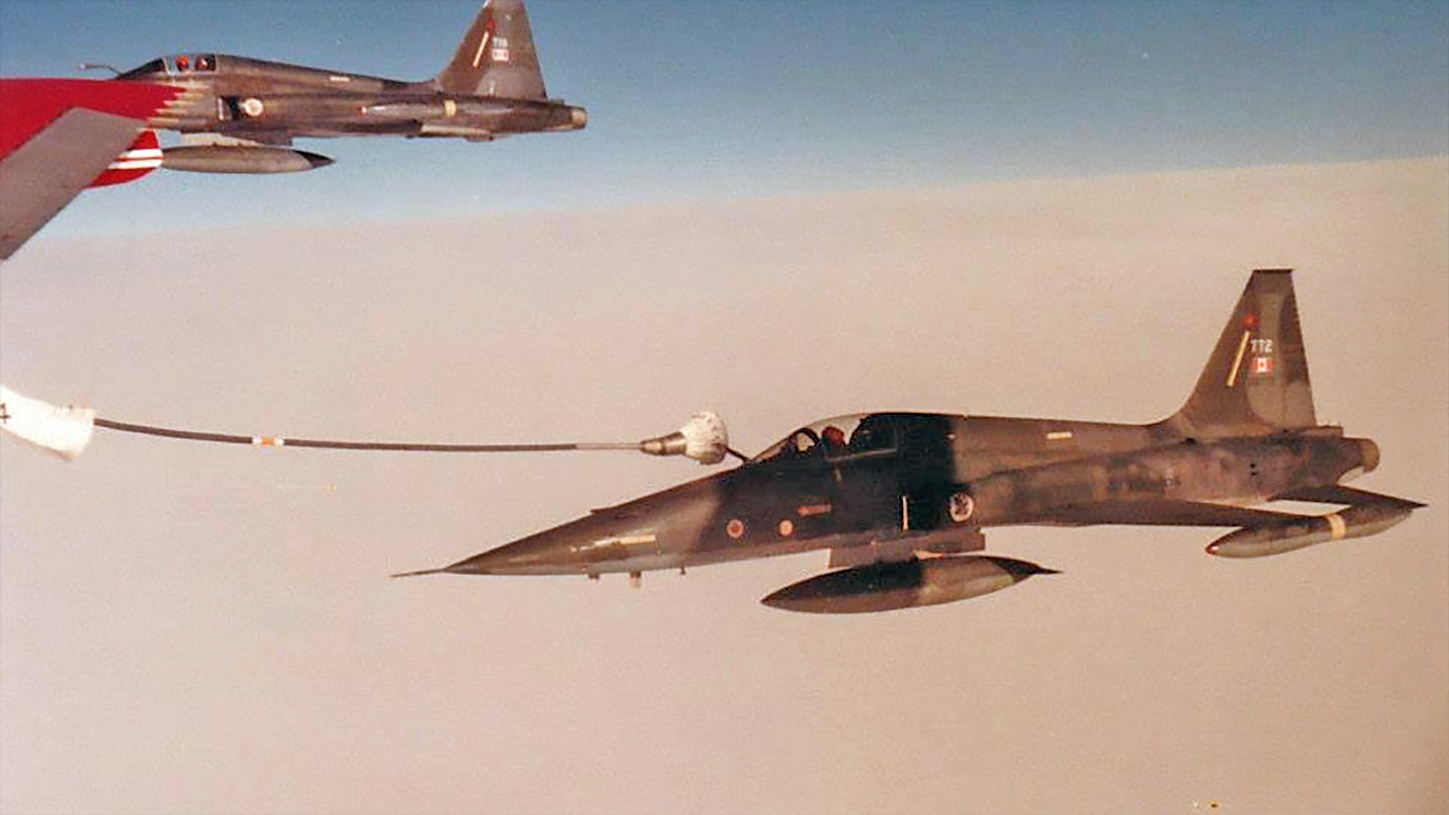“Echo Four, cleared wet contact right hose,” crackled the radio in Paul’s helmet. He gripped the controls on his CF-5A Freedom Fighter a little more tightly, focusing on the steel basket that would deliver much-needed fuel to his little jet.
The basket bobbed gently behind the wingtip-mounted pod on the military Boeing 707 tanker in light turbulence. Paul, or “P.I.” as he was known to his friends on 433 Tactical Fighter Squadron in Bagotville, Quebec, Canada, ignored the rush of the cloud deck that was barely 1,000 feet below their formation. His Indicated Air Speed (IAS) of 290 knots translated to about 400 miles per hour or 650 kilometers per hour at their altitude of 30,000 feet.
As the last to plug-in of the four aircraft in 433 Squadron’s ‘Saguenay Echo’ formation, his fuel quantity was the lowest. He had to make a successful plug quickly. Luckily, P.I. was an old hand at aerial refueling by now, and conditions were good. It was light out, and they were in clear air above the solid undercast cloud.
He advanced the twin throttles with his left hand, and established the ‘sight picture’ he wanted – the 300-pound basket formed the lower circle of an offset figure eight, and the ‘bell mouth’ on the wingtip of the big tanker/transport was the upper circle. Moving slowly toward the basket, he occasionally glanced at the probe sticking out from his right fuselage ahead of the windscreen, ensuring it would enter the basket and make the required connection.
With a gentle clunk, he made contact with the basket, and continued moving forward to push the long hose forward into the bell mouth, thus permitting fuel to flow into his thirsty aircraft. Paul smiled, pleased that the contact had gone well. He relaxed slightly on the controls, concentrating on maintaining his position relative to the 707’s wingtip.
“What? Crap!!!”
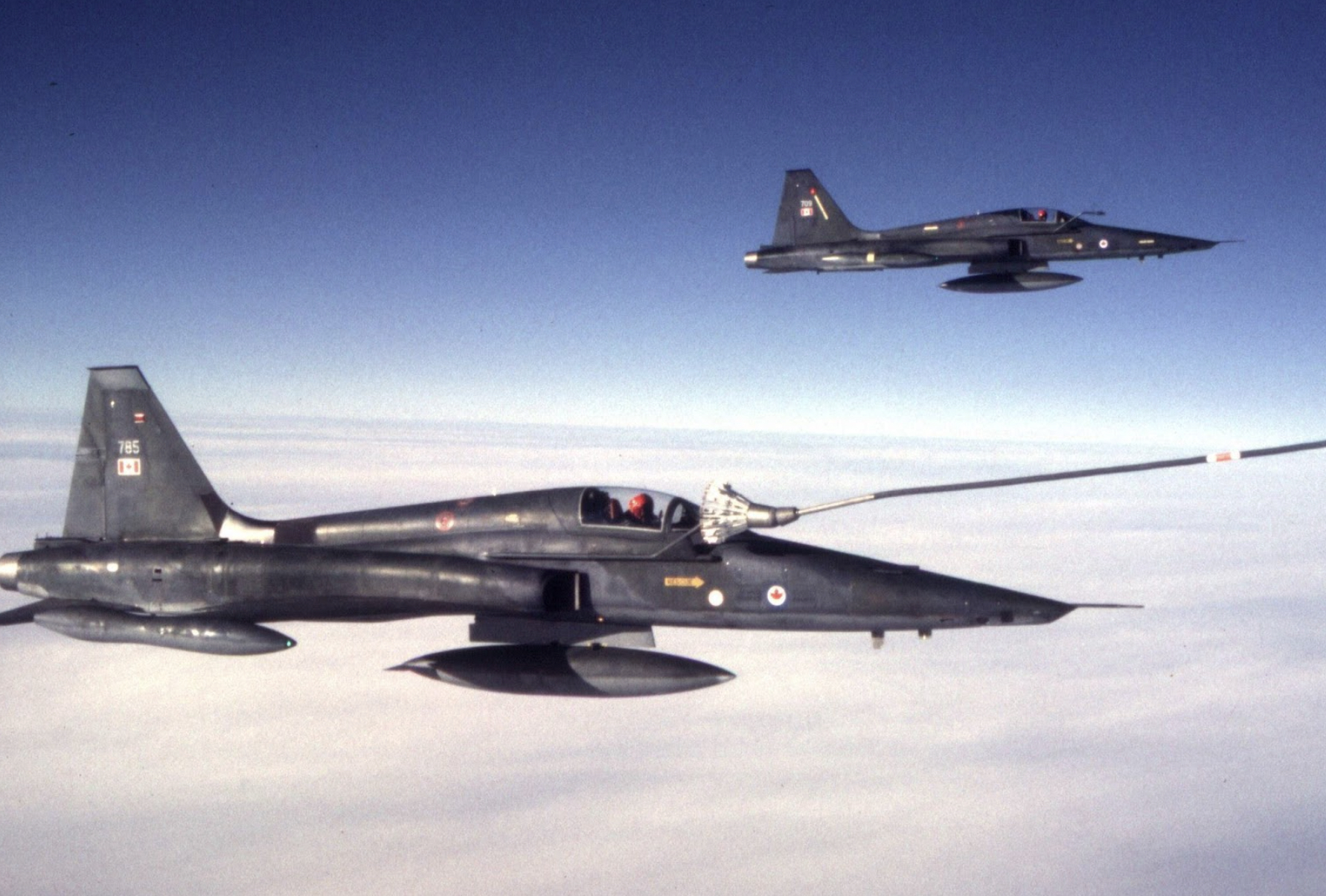
He heard two ‘pops’ from his J-85 jet engines, as they both ‘compressor stalled’ and stopped working, losing thrust instantly.
The sinking feeling in his stomach was all too real, as his now unpowered fighter fell off the hose, drifting back quickly from the tanker and sinking toward the cloud deck below. The refueling basket disconnected from his probe, spraying jet fuel as it bobbed wildly in the air above and ahead.
How did we get here?
Canada’s CF-5 fighters were flown by two squadrons (433 and 434) whose role was reinforcement of NATO’s Northern Flank. They deployed regularly across the North Atlantic, refueling all the way, to land at their deployed operating base in Andoya, Northern Norway. Before this deployment, though, there had been a rash of compressor stalls in the fleet. The F-5 had long, slim air intakes with tiny apertures in front. The little jet engines, despite their size, still demanded a high volume of air to produce thrust at high power settings or in afterburner (AB).
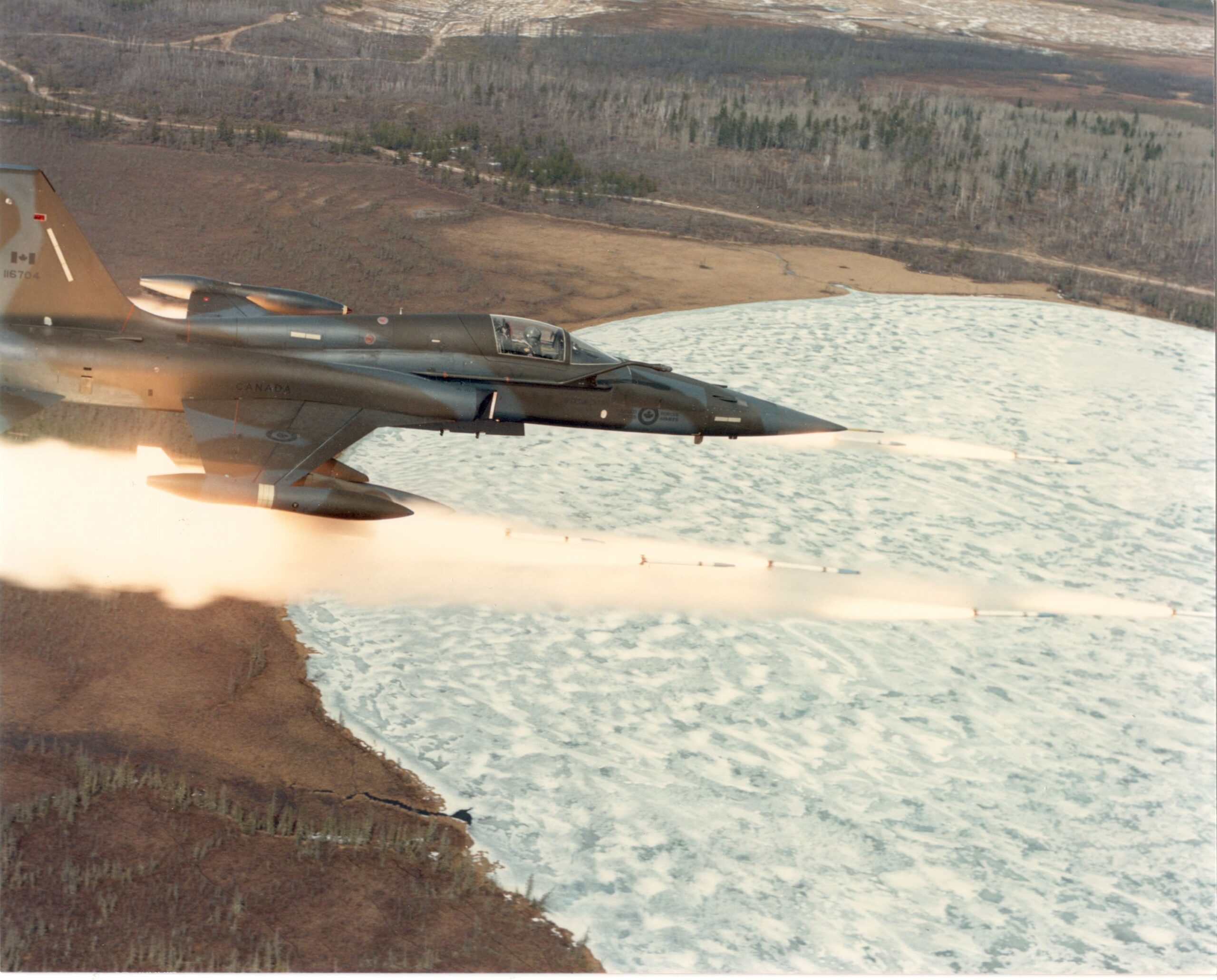
When performing simulated air combat, pilots often generated side slip or yaw, which would regularly cause one of the two engines to be starved for air, resulting in a compressor stall. Sometimes the engines would wake up on the wrong side of the bed and decide to fail/compressor stall in an unpredictable fashion.
In short, the CF-5 fleet had a problem with engine reliability.
The Commanding Officer of 433 Squadron, LCol Jean Boyle, had written a letter to higher command stating that he believed the aircraft was unsafe to fly across the ocean, due to its propensity to lose engine(s) unpredictably. He was told by his headquarters to ‘suck it up’ and ‘do his job.’ Well, the response was probably couched in kinder bureaucratic language, but that was the message he received as his plea fell on deaf ears.
Fast forward to today, March 11, 1984. Two CC-137 (Boeing 707) tankers and eight CF-5As left from Goose Bay, Labrador, destination Andoya, Norway. On board the tankers were additional pilots from 433 fighter squadron, their ground crew, and supplies for the deployment.
As is often the case with Canadian military deployments, there was little margin for error. Instead of taking off from home base at Bagotville, the fighters had staged to 500 nautical miles closer to Europe, landing and refueling at Goose Bay, Labrador. This was necessary because the 707s had barely enough fuel to make the transit from Goose to Andoya, loaded with equipment and personnel while transferring enough fuel to the fighters for them to make it to Norway.
The two tankers would each shepherd four fighters, planning four fuel transfers to each of them along the way. This was necessary so that the fighters would always have enough fuel if anything happened to divert to an airfield along the way (Greenland, Iceland, the U.K., etc.).
P.I. was in the second formation of fighters and their tanker, trailing about five minutes behind the first group.
The weather was cloudy in Goose Bay. The fighters took off first and remained below the clouds. They turned back and flew opposite to their take-off direction in a race-track pattern, as their tanker took the runway.
“Husky is rolling” called the 707, as it started its take-off roll.
The leader of Saguenay Echoes, Paul’s formation, timed the turn expertly so that two fighters ended up flying alongside the 707’s right wing and two others by its left wing as it lifted off the runway.
Just before the tanker entered the clouds, Paul was tucked into close formation on Major Michel Prudhomme’s wingtip, as ‘Prudy’ flew visual formation on the tanker’s wing. The CF-5 had no radar, so this was the only way to ensure they could safely follow the tanker up through clouds.
Today their climb was long and stressful, as they flew in clouds until 30,000 feet, then leveled off at 31,000 feet just above the clouds for the long transit.
The first refueling bracket had gone well, everyone taking fuel then spreading out into a relaxed ‘route’ formation until the second, fateful refueling session.
Pop op, followed by a sinking feeling.
Now, after losing both engines, P.I. was flying a 16,000-pound glider, plunging quickly into the cloud toward the frigid North Atlantic below. To make things worse, when the engines failed the ‘bleed air’ from the compressors ceased working. The rubber seal on his canopy that kept the little cockpit pressurized immediately deflated, and the rapid decompression caused the air inside to equalize to the one-quarter atmospheric pressure above 25,000 feet. Net result: depressurizing air, instant cooling, instant fog.

He could barely see the instruments as he squinted through the air in the cockpit. To avoid inducing an out-of-control situation, he maintained a very light grip on the stick, knowing that the agile little fighter could very quickly end up on its back with the slightest pressure on the control column.
His mind raced quickly through the required actions. The CF-5 needed to fly at 260 knots indicated airspeed (IAS) to remain gliding. He instinctively set up the glide, meaning he was rapidly losing altitude in the clouds. Slowly, the fog dissipated in the cockpit as the pressure equalized with outside, and his ears were assaulted by the loud rush of high-speed air past his jet, no longer attenuated by the pressurization.
This was the least of his worries.
All of his primary flight instruments (attitude indicator, heading) and his ultra-high-frequency (UHF) radio operated on alternating current (AC) power. That power came from the engine-driven generators in his jet and now both of those generators had failed, because they only operated when the engines were running.
A glance at his instrument panel confirmed the situation. His main attitude indicator (which is used to set the orientation of the aircraft by the pilot), was useless, tumbling as its gyroscopic stabilization wound down.
By his right knee, his tiny gyro-driven standby attitude instrument was only reliable for a minute or two before it would also ‘topple’ and become useless.
P.I. was unable to talk to anyone about his predicament, since his radio had failed. Talking, though, was Paul’s last priority. Aviate, Navigate, Communicate. These were priorities that were hammered into each military pilot during training.
While frantically trying to restart his engines, he needed to control his jet in the clouds, with limited instruments (aviate). Glancing at the only compass available (a ‘whisky compass’ standby instrument that was rotating back and forth, only partially readable), he realized that the ‘navigate’ part would have to wait.
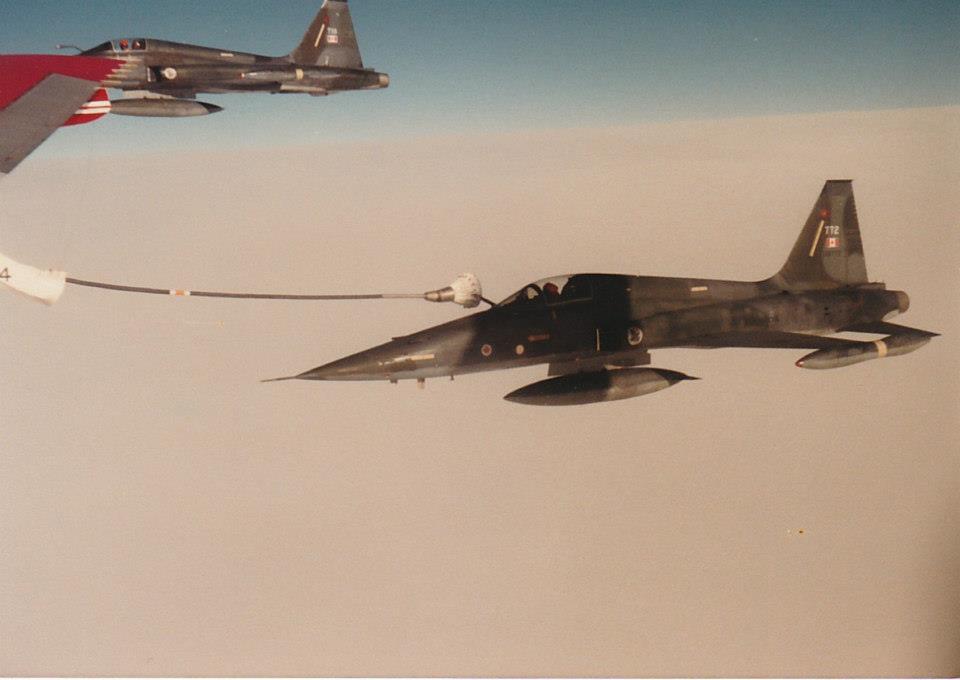
Paul reverted to ‘partial panel’ flying, using the standby J-8 attitude indicator to attempt to keep his wings level. He knew that in a couple of minutes that instrument would also be unusable. He relied on the elevator trim to keep the speed constant at 260 knots in the glide. Luckily, the engines were still turning due to airflow from his speed (windmilling), turning their hydraulic generators sufficiently to power his flight controls.
In the back of his mind, he knew that he might have to eject, splashing into the near-freezing ocean. Then, he could only pray that the Hercules ‘duck-butt’ might find him and drop a larger raft and supplies to him while he awaited pick-up by a surface vessel. He was wearing an uncomfortable immersion suit that would help him survive some time in the water and in his tiny life raft, but not for long.
The duck-butt was a CC-130 Hercules transport that had departed two hours ahead of the formations, flying along their route. It carried air-droppable supplies as an emergency measure. The Herc would be overtaken by them, landing four hours after the high-flying jets in Andoya.
P.I. had no clue where the Herc might be, and had no means of contacting it anyway with his failed radio. Also, he had no way of telling them where he was, since he was out of range of any navigation aids. The CF-5 had no inertial navigation system, and none of this would have worked with no AC power anyway…
In short, he was screwed if he didn’t sort out the engine failures immediately.
There were two means of restarting the J-85 turbojet engines in-flight. One was using the regular starter system, relying on the windmilling engines to turn the compressors while they relit. It could take up to 30 seconds before they wound up to idle RPM, then he’d have to ease the throttles gently forward to stop descending, hoping the engines wouldn’t die in the process.
The fastest type of relight that would provide much-needed thrust far more quickly was a ‘Tiger’ start. This entailed slamming the throttles forward into afterburner range (AB), where the engines would auto-relight. They would then spool up quickly into AB, solving his thrust and electrical power problem.
In theory.
He attempted multiple tiger starts, and got one engine relit in AB as he descended through 24,000 feet. Only 6,000 feet below where he lost the engines? This is a testament to just how quickly his mind was racing through actions, and how he was frantically trying tiger starts even as he sorted out his priorities for aircraft control. It took him less time to restart the first engine than it took you, the reader, to absorb the paragraphs above.
With one engine now in afterburner, he was able to maintain 260 knots only if he kept descending. The little engine didn’t have quite enough thrust to maintain level flight at that altitude, even in full AB. The good news, however, is that instead of descending at over 4,000 feet per minute, his descent rate was on the order of several hundred feet per minute, giving him more time.
Finally, after multiple attempts, he was able to get the second engine relit at 20,000 feet.
Phew!
Flying with reference to partial instruments, he coaxed the speed up to 350 knots (normal climb speed), and started a climb. Glancing at his fuel indicator, he realized he couldn’t fly in AB for much longer before running dangerously low on fuel. He hadn’t taken on much fuel before his engines had failed, and now his biggest problem was figuring out where to go. He had no navigation instruments, his radio was just now coming back online, and he had no idea where the tanker was, let alone a diversion airfield.
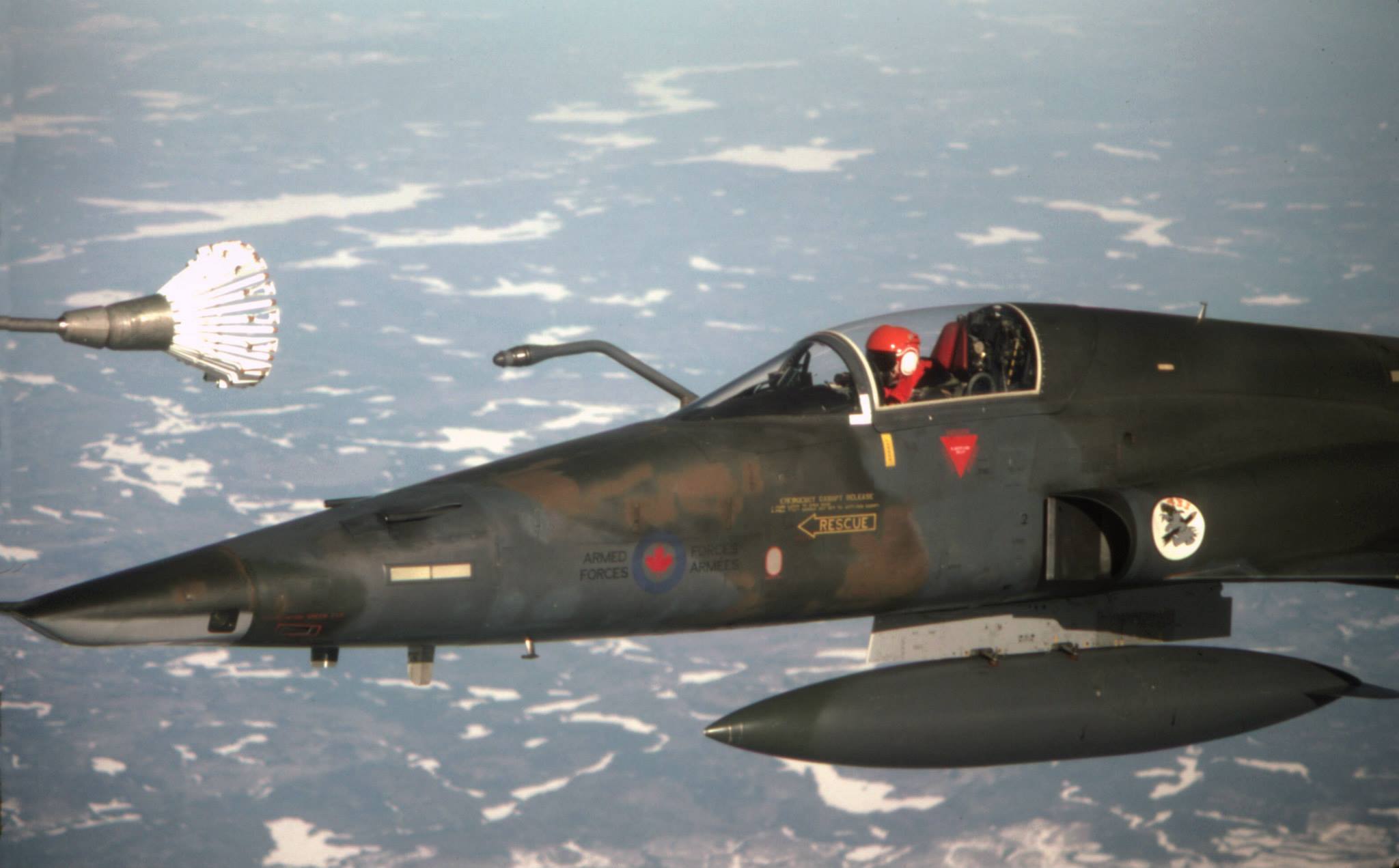
With a deep breath, he gently clicked the engines out of afterburner. Okay. They didn’t fail. The transition from AB to military power was notorious for causing the J-85s to fail, but not this time. He continued his gentle climb toward clear air above the cloud, and contacted the tanker formation.
Michel Prudhomme had seen Paul’s jet drop rapidly off the hose and disappear down into the cloud below. He correctly surmised that Paul had lost both engines, and told the tanker crew that they needed to loiter in place, hoping that P.I. would get a relight and be able to rejoin with them above the clouds.
While Paul struggled with his crippled jet, a tense radio exchange occurred between the fighter lead and the tanker commander. The 707’s pilot told the fighter lead that he couldn’t turn back – he had insufficient fuel to deviate backward and still make it to Norway. The fighters won the argument, and convinced the 707 to turn back.
Just as this was resolved, Paul’s voice came on the UHF radio, calmly announcing that he had regained engine thrust and was climbing back up through the weather.
There was no time for celebration. The top priority was now to figure out where the lost fighter was and to bring him back into the formation. Nobody had on-board radar to find number four. Even when P.I. got back above the cloud, he was more than 70 miles from his formation, well out of visual range. Also, Paul had no useable flight instruments, and had to rely on his standby compass for direction.
As Paul’s electrical system returned to normal (both generators now working), his tactical air navigation (TACAN) system achieved a lock-on in air-to-air mode. This gave him a distance readout from the formation, showing him that he was over 70 nautical miles away. Using a vector from an American military radar station in the mid-Atlantic, the lost fighter and tanker formation were able to point at each other. They used a technique they often practiced to do a head-on rejoin, and finally number four was back on board, heading once again eastbound toward Europe.
Only two big problems: Paul was running very low on fuel, and the tanker had insufficient fuel to take them all to Norway now.
While the tactical navigator on board the 707 burned through pencil lead trying to find a solution for the problem, Paul plugged into the hose again with a sigh of relief as his thirsty jet started filling up with precious fuel.
Discussions were happening within the tanker, and with the fighter lead. Can we make it? If not, where do we go? Do the fighters go to Andoya, while the tanker lands somewhere short? What about the much-needed personnel and equipment aboard the tanker? There were no easy solutions coming to the fore… until another oddly calm transmission once again changed everything.
“Lead, four has an engine fire” came the call from P.I., still plugged into the tanker’s hose, taking on fuel.
He dropped off the hose without waiting to be told to do so, and looked inside. With the throttle retarded on the left engine, its fire light went out. Slowly, P.I. advanced the left-hand throttle. Nearing military power, the master warning started flashing again, and the engine fire light came back on.
“Prudy, are there any flames coming out of my number one engine?”
“Negative” came the reply.
“When I retard the throttle, the fire light goes out.”
His number three, Prudy, took things in hand.
“Keep it that way P.I. We’re going to go and land somewhere.”
“Let’s have a vector to Keflavik, Husky,” he asked. This also implied that the 707 crew would arrange an Instrument Flight Rules (IFR) clearance for him and P.I. to fly to Keflavik, Iceland, for an emergency landing. Only the 707 had an HF (High Frequency) radio that could talk to ATC this far from land.
In record time, Husky arranged for the two fighters to leave the formation and head to a landing in Iceland. It’s very likely the tactical navigator was quite happy with this turn of events – suddenly their fuel problem was solved with two fewer fighters sucking up their allotment of jet fuel.
P.I. and Michel landed safely in Keflavik, and the 707 with its smaller formation of fighters eventually landed in Andoya. A Hercules showed up the next day in Keflavik with parts and technicians to repair the stricken fighter, and Michel and P.I. rejoined their squadron mates after flying multiple hops across the rest of the Atlantic to Norway.
Two years before this event, my father and I were both instructing budding young pilots in Moose Jaw, Saskatchewan on the Wings training course. P.I. was Dad’s student. He confided in me at the time that P.I. was one of his best students ever, and that he’d do fine flying fighters.
Dad was right. Paul used all of his training and abilities to calmly deal with a dire situation that could have been disastrous in many ways.
Now, P.I. is working as a doctor, a career he chose after flying both the CF-5 and CF-18 in Canadian service. He spent 15 years as an Emergency Room physician, then moved on to family practice. Patients were blessed to have such a calm and competent professional taking care of them. He still practices medicine, including aviation medicine.
For some reason, he has a soft spot for professional pilots.
Retired Major Dan McWilliams logged 3,200 hours over 20 years in the Canadian Air Force, flying the CT-114 Tutor, CF-5, T-33, and CF-18. A specialist in Electronic Warfare and software, he managed a group of engineers developing mission-critical software for the CF-18 and for CF-18 simulators. He later flew and instructed in the Challenger 604, tested full-mission simulators for military customers, managed a CF-18 mission training center, and taught at an aviation college.
Contact the editor: tyler@twz.com
